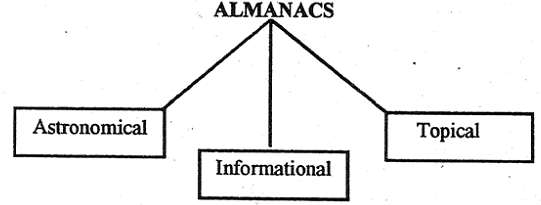Almanacs
This section deals with almanacs. Like yearbooks, almanacs are also periodically published ready reference sources with similar objectives. Almanac literally means calendar of months and days containing astronomical and nautical information about the sun, moon, tides, anniversaries and so on. It is an annual calendar considering miscellaneous matters such as planetary tables, astronomical events, astrological predictions and anecdotes. But the meaning of the word `almanac' has undergone semantic change in recent days. The common meaning of almanac is an annual compendium of statistics and facts, both current and retrospective. It can widely cover a specific region or subject or it can be limited to a particular nation, country or state.
Thus, while the Shorter Oxford English Dictionary defines an almanac as "an annual table or book of tables, containing a calendar of months and days usually with astronomical data and information". Harrod's glossary calls it "a publication, generally annual, havinga variety of useful facts of a miscellaneous nature and statistical information". Librarians frequently use them as ready reference sources of statistics. At this juncture, let us compare and contrast between the yearbooks and almanacs. Though they are two distinct types of reference books, still they are similar and closely related to each other in scope and use. They are always grouped together as ready reference sources.They have fixed periodicity and are published every year.
The major distinction between the two is in coverage in the form of duration. A yearbook is an annual compendium of descriptive and statistical data of the past year whereas the almanac inevitably covers retrospective information too. Again a yearbook is published annually but almanacs vary in periodicity e.g., Congressional Quarterly Almanac or the Almanac of American Politics (biennial), Almanac of Famous People (irregular).
Almanacs are grouped into three distinct categories according to the scope, purpose and coverage of information.
